Abrolhos seascape, a field demonstration model
16.06.2011
-
SUBMITTED ORGANISATION :
-
Conservation International
-
DATE OF SUBMISSION :
-
16/06/2011
-
REGION :
-
South America
-
COUNTRY :
-
Brazil (Caravelas, Bahia)
-
SUMMARY :
-
The Abrolhos Region off of Brazil’s southeast coast is a natural paradise for biodiversity and people. The waters are the most biodiverse in all the South Atlantic, full of an incredible array of marine life. Once a year over 7,000 humpback whales come to Abrolhos to reproduce. Residents depend on the sea for their livelihoods, working as fishermen, collecting crabs in the mangroves, and developing tourism. Over the last 13 years, Conservation International (CI) has been working in the Abrolhos bank to design and implement a network of multiple-use and no-take marine protected areas (MPAs). CI-Brazil’s model combines institutional commitment, good science, and strong partnerships to develop an effective ecosystem-based management system for the region. Local-level results are amplified through a series of concrete activities that influence regional and national policy, build local capacity, and increase awareness. This model is already proving successful in shaping an economic development pathway that is built on the central and fundamentally essential role of nature. The road toward sustainability is being paved in Abrolhos.
CI works with societies to secure ecosystem services that flow from natural systems to meet both current and future needs. The key to securing ecosystem services for the benefit of people is to demonstrate success in specific places and then scale-up those successes for broad-level impact. -
KEYWORD :
-
Brazil, Abrolhos, marine conservation
Background
The Abrolhos Region is located off the southern coast of the State of Bahia, Brazil (Figure 1). It is an area of 95,000 km2 where the continental shelf extends far into the ocean leaving an area of relatively shallow water (~20-70 meters). Abrolhos is a mosaic of important ecosystems including coral reefs, mangrove estuaries, calcareous algae-covered substrate, and beaches.

As the most biodiverse area in the South Atlantic, the Abrolhos Region houses numerous endemic species such as the brain coral (Mussismilia braziliensis) and various threatened species such as sea turtles, sea birds, marine mammals and fishes. In a rapid assessment conducted in 2003 a total of 1,300 species were documented, 45 of which are listed as threatened on the IUCN Red List.
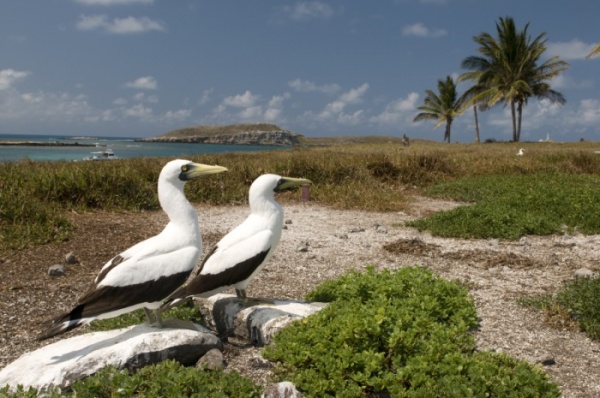
Approximately 230,000 people reside in the coastal area adjacent to Abrolhos. Many people engage in traditional livelihood activities and it is estimated that 20,000 residents are employed as fishermen. The region experiences an influx of national tourists during holidays and also receives hundreds of international tourists during the whale watching season from June to September. Approximately 80,000 residents are employed in the tourism sector, which is a growing activity in the region.
To conserve the area’s unique biodiversity and ensure long-term livelihood opportunities for local people, several marine protected areas (MPAs) have been established. Currently, the core MPA network includes four Federal protected areas: the Abrolhos Marine National Park, Corumbau Marine Extractive Reserve, Canavieiras Extractive Reserve, and Cassurubá Extractive Reserve (Table 1).
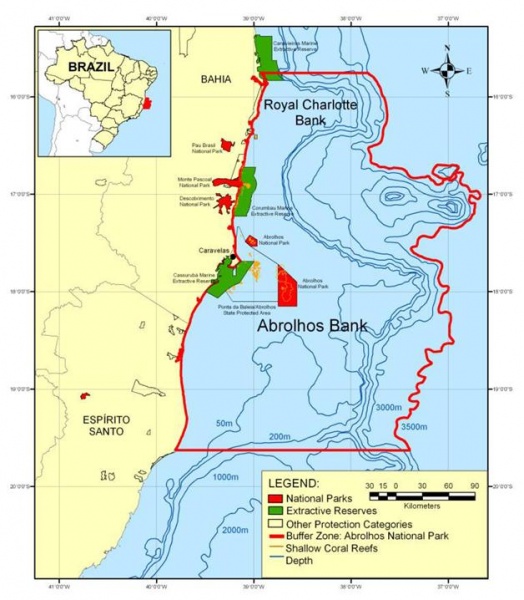
Figure 1. Location of the Abrolhos Region and its protected areas.
| Table 1. Marine protected areas of the Abrolhos Region | |||||
| Protected Area | Date | Surface Area | Ecosystem | Management Regime | Zoning |
| Abrolhos Marine National Park | 1983 | 88,250 hectares | Islands and coral reefs located 45 miles off the coast | Administered by the Chico Mendes Institute for Biodiversity Conservation (ICMBio) | No-take protected area; allowed activities include tourism and research |
| Corumbau Marine Extractive Reserve | 2000 | 89,500 hectares | Coral Reefs, shrimp banks that are a coastal marine area adjacent to two national parks protecting remaining blocs of the Atlantic Forest | Co-managed by ICMBio, local communities, and several nongovernmental organizations including CI | Multiple-use area including some no-take zones |
| Canavieiras Extractive Reserve | 2006 | 100,000 hectares | Coastal marine and mangrove areas | Co-managed by ICMBio, local communities, and several nongovernmental organizations including CI | Multiple-use area including fisheries management regulations |
| Cassurubá Extractive Reserve | 2009 | 100,000 hectares | Coastal marine and mangrove areas | Co-management; management structure under development | Zoning under development |
Science
CI’s work on the Abrolhos Region is driven by science. For over a decade, CI-Brazil and its partners have been conducting both ecological and socio-economic research to improve priority-setting and inform management decisions. Most recently, much of CI-Brazil’s research has been conducted as part of the Marine Managed Areas Science (MMAS) program, a CI-led initiative to conduct research in several important marine areas worldwide. The objectives of this program are threefold:
Create local capacity for marine conservation
Evaluate the effects of MPAs on ecosystems and people
Conduct science to improve MPAs design and implementation

In Abrolhos, MMAS has enabled cutting-edge inquiry into the connectivity among habitats, namely mangrove estuaries, near shelf reefs and outer shelf reefs. Results of this research indicate that these habitats are connected and that various species of fish may use these multiple habitats throughout their life cycles. The implication is that protected areas are needed in these multiple habitats to ensure ecosystem functionality.
Habitat mapping has resulted in the identification of new reefs further offshore that may multiply the total reef area of the Abrolhos bank by two to seven times. Through MMAS, CI-Brazil has also been involved in the identification of new, hole-like formations in the substrate. Although still not well understood, these formations may serve as refuges for fish seeking protected water or hiding from predators. Even further, beyond these newly-identified structures, are large calcareous algae banks, which may play a role in reducing CO2 concentrations in the atmosphere but which require further study.
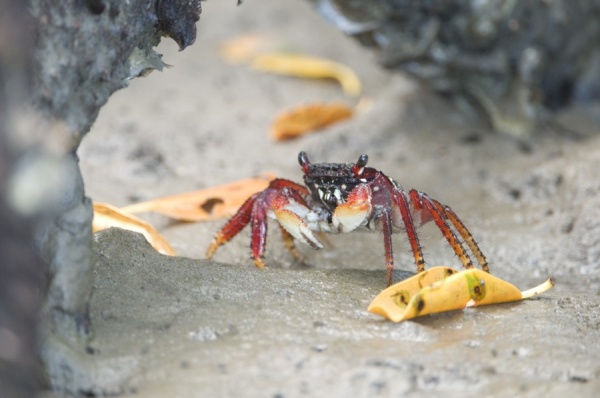
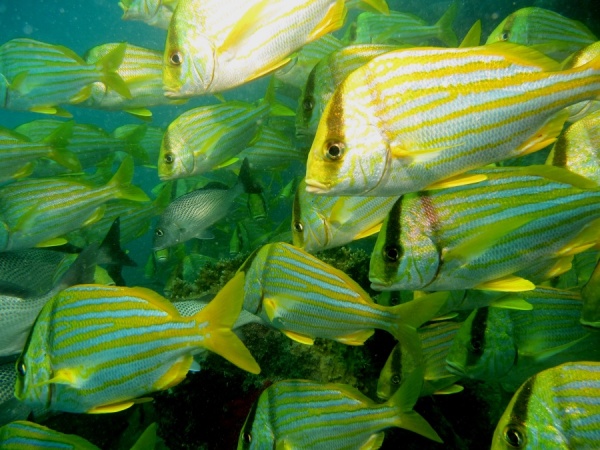
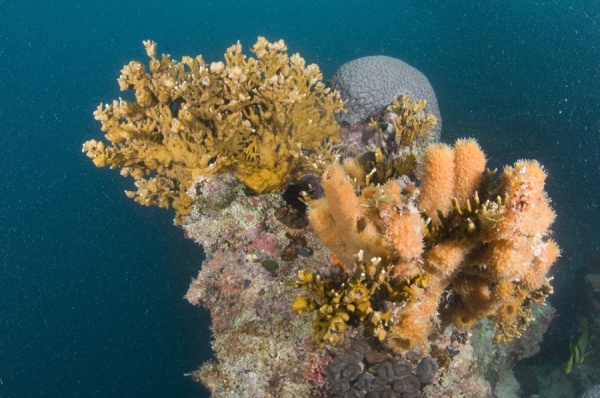
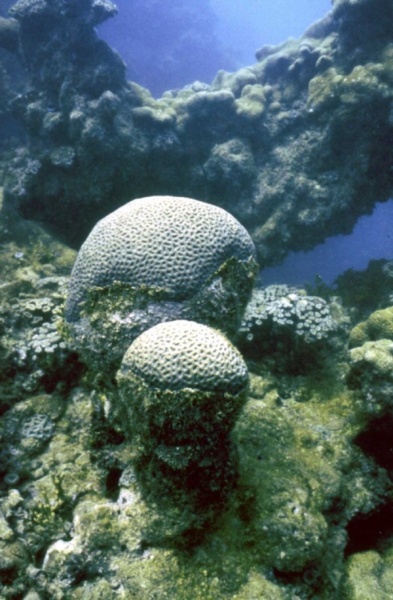
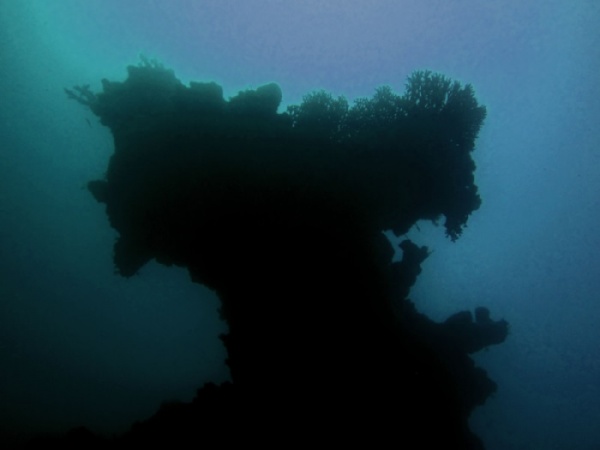
In addition to habitat and connectivity research, CI-Brazil and its partners have conducted a number of studies to understand the effects of MPAs. For instance, a recent study looked at fish biomass of commercially-important fish species in a no-take zone inside the Corumbau Marine Extractive Reserve as well as at increasing intervals from the borders of the no-take zone. Results indicate that fish biomass is increasing inside the Reserve boundaries and that there is a positive spill-over effect outside as well. This is important information for managing multiple use MPAs and including no-take zones within them. Still other studies have focused on identifying spawning aggregation sites and understanding population dynamics.
Biological and ecological data has been coupled with socio-economic information. In 18 communities along the Abrolhos coastline, CI-Brazil and its partners are conducting research to understand the socio-economic impacts of MPAs as well as the cultural dimensions associated with MPA management.
CI-Brazil and its partners also undertake regular monitoring activities to track trends in biodiversity and fisheries. This information has demonstrated the impact of MPAs in improving fisheries and biodiversity conservation. It has also identified problems such as coral bleaching and disease. These are symptoms of threats such as overfishing and perhaps climate change. Research on the impacts of climate change may provide insight into ecosystem vulnerability and adaptation measures that should be put in place.
The aim of this research is to inform the development of a holistic management plan for the entire Abrolhos Seascape, targeting the maintenance of the most critical ecosystem services and sustainability of fisheries.
Ecosystem-based management
CI-Brazil is influencing the development of a sustainable, ecosystem-based management model for the Abrolhos Seascape by conducting rigorous scientific research and working with a network of strong, committed partners. To conserve ecosystem services and ensure the functionality of the Abrolhos ecosystem, MPAs must be established in a network that promotes connectivity. This vision is well on its way to becoming a reality through multiple MPAs with various conservation objectives.
The key to CI-Brazil’s model for achieving results at Abrolhos is developing a robust approach that demonstrates how conserving the natural ecosystem ensures the delivery of important ecosystem services that are needed by people.
Success of the Abrolhos model is contingent upon its ability to deliver sustainability – ecological, political and financial.
Ecological sustainability – CI-Brazil is working toward ecological sustainability by establishing protected areas and implementing appropriate use rules. Research indicates that Abrolhos MPAs have had important successes to be replicated. Fish populations are stable inside multiple-use reserves such as Corumbau while they continue to decrease outside the reserves. This clearly demonstrates a strong potential for achieving food security for over 15,000 people relying on the MPAs. Also, reef fish species abundance has increased not only inside MPAs, but also close to their borders, demonstrating the positive spill-over effects of conservation.
The Abrolhos model is incorporating measures to address new threats such as climate change. Research on coral bleaching, disease and susceptibility will inform the identification of areas that must be protected to facilitate adaptation and make the system more resilient to climate change. At the same time, scientific knowledge of calcareous algae banks is elucidating the role of these marine habitats in reducing CO2 concentrations in the atmosphere.
The marine extractive reserves are strong instruments for securing traditional territories and ways of life. By relying on both traditional and scientific knowledge to inform the management of Abrolhos, local cultural practices that contribute to the maintenance of healthy natural ecosystems are recognized for their contribution to the provision of ecosystem services. Traditional Knowledge, which refers to the “innovations and practices of indigenous and local communities around the world”, has made a significant contribution to sustainable development. This knowledge and practice of using biological diversity at the local level in a sustainable way, even promoting biodiversity, helped the management of vital ecosystems in Abrolhos. This interdependent relationship between humans and nature has been mutually beneficial, specifically in the Abrolhos model.
Political sustainability – The governance structures of the individual MPAs in the Abrolhos MPA network are essential building blocks of creating and maintaining political will for conservation. They bring together multiple stakeholders including government, nongovernmental organizations, universities, research institutes, labor unions, fishermen’s associations, and the private sector. The coalition of these groups has resulted in a critical mass of support for conservation robust enough to withstand powerful external interests that favor destructive economic development alternatives. A key component of developing a strong governance regime is ensuring adequate capacity for making decisions, implementing actions, conducting evaluation and adapting strategy. We are working with our partners to address these needs and are already witnessing impressive advances in local capacity for marine and coastal area governance.
Financial sustainability – The Abrolhos model will not persist without financial sustainability, both to cover the costs of management and to ensure sustainable livelihood options are lucrative for local people. CI-Brazil’s work in this area is ongoing, but progress has already been made. To secure funding to cover management costs, we are working with our partners to establish the Abrolhos Trust Fund. This fund would be endowed and then used for complementary management costs such as monitoring, awareness building and patrolling, when government funds are scarce.
Efforts are also underway to develop and improve sustainable livelihood options and to shape the local economy into one that conserves Abrolhos’ natural resources. A specific initiative includes working to increase fishermen’s income through sustainably improving commercialization of local fish products in Corumbau and Canavieiras Extractive Reserves. To improve incomes from local fisheries, we are working to strengthen local fishing associations, engage the market and establish incentives for buyers to procure directly from associated fishermen who can provide higher quality product.
Abrolhos delivers ecosystem services for the benefit of peopleCI focuses on six initiatives to ensure human well-being: climate, water, food security, health security, cultural services and species contributions. In Abrolhos, we are addressing four of these directly.Conserving the species of Abrolhos is important because they are the building blocks upon which human activity depends.
By protecting Abrolhos, CI-Brazil is working to ensure food security for local people who depend on fish, crab, and other seafood for their sustenance and their livelihood.
In our ecosystem-based conservation model, we build upon existing cultural links with nature, protecting the cultural services that Abrolhos provides.
CI-Brazil is helping to achieve climate security by conserving the coastal and marine ecosystems at Abrolhos that regulate climatic conditions.
Amplification
CI’s efforts in Abrolhos are proving successful but these positive results must be amplified if we are going to affect a larger scale. Our approach to scaling-up our impact includes applying lessons learned in Abrolhos to other areas in Brazil, influencing national policy, building capacity, and improving communications.
The approach in Abrolhos is already being recognized as a model that should be replicated to other areas of Brazil. Recently, CI-Brazil was asked to provide technical support to marine conservation efforts ongoing off the coast of the State of São Paulo. Stakeholders in São Paulo acknowledge the expertise and experience CI-Brazil can bring to this process and have requested assistance. This is a clear indication of CI’s growing role in developing field models, testing them, and amplifying results through sharing the lessons with others.
The Brazilian government has been impressed with the quality of CI-Brazil’s work and the compelling scientific information we are able to produce. As a result, the Brazilian Ministry of Fisheries invited CI-Brazil and partners to develop an innovative methodology for monitoring small-scale fisheries in the region to improve the national protocol used all along the Brazilian coast.
Policy
CI-Brazil has been providing information to decision makers and influencing national policy since the early days of our engagement in the Abrolhos Region. In 2003, the government of Brazil proposed selling permits to explore for oil and gas in the area. This prospect was of immediate concern to CI and our partners in the region because this type of exploration could have devastating effects on Abrolhos’ marine biodiversity, ecosystem services, and local livelihoods, regardless of whether oil or gas were actually exploited as a result of exploration. The potential negative impact was exacerbated by the fact that 243 blocks would be offered in the region, covering near 75% of the Abrolhos bank.
To reverse this decision, CI-Brazil and close partners took the lead in creating a group of like-minded stakeholders including environmental organizations, universities, and local associations. The purpose of this group, which came to be known as the SOS Abrolhos Coalition, was to advocate for the long-term conservation and sustainable use of Abrolhos’ resources. After months of organizing, developing policy briefs, communicating scientific research to policy makers, and garnering support from a wide constituency, the SOS Abrolhos Coalition was successful in persuading the government not to issue exploration permits in the area. It was a victory in governance and sent a strong message that zoning is a critical component of sound economic development policy and trade-offs must be considered carefully.
More recently, the SOS Abrolhos Coalition played an important role again when the Cassurubá mangrove estuary was nearly transformed into the largest shrimp farm in Brazil. Shrimp farming would be extremely destructive in this area. Creation of shrimp ponds would require clearing vast areas of mangroves and other vegetation, and the estuary would become contaminated by the waste generated by the farmed shrimp. Because the estuary is the nursery for many reef species, this could negatively impact the numbers of larger fish found in deeper waters. The result would thus be devastating to local people who live off the resources, both in the estuary itself and further offshore.
In an unprecedented effort, the SOS Abrolhos Coalition launched an advocacy campaign that touched all sectors and reached the highest levels of government. The end result was a monumental visit by President Luiz Inácio Lula da Silva to Caravelas to sign the decree creating the Cassurubá Extractive Reserve in 2007. CI-Brazil, its partners, and local people were vindicated by this event, which was a clear demonstration of the power of sound science, good management models, and persistent advocacy.
Capacity building
CI-Brazil’s effort to scale-up its impact includes building capacity for scientific research and conservation. CI believes that science should be used to inform appropriate action and that scientific capacity needs to be cultivated to ensure this function in the future. As such, CI has developed a Science-to-Action program, which aims to generate scientific knowledge and expertise as input to decision making. As part of its Science-to-Action program, CI-Brazil is working to prepare the next generation of decision makers, scientists, and resource users. Two programs are currently underway to build local capacity in marine science:
Marine Protected Areas Monitoring Course – This is the only such course in Brazil focused on the adaptive management of MPAs. It involves students and MPA professionals and managers from all over the country and is offered annually by Alliance for Marine Conservation, a partnership between CI-Brazil and the SOS Mata Atlântica Foundation. The course provides participants with knowledge and skills to design, implement, and assess the results of marine monitoring programs. It includes both classroom and field components. To date 55 people have completed the course from institutions of more than 10 different states in Brazil.
Open Your Eyes to Science – This program, developed by the State University of Maringá (UEM) and CI-Brazil, is an innovative capacity building initiative targeting high school students. Supported by the National Council for Science and Technology and the Bahia State Foundation for Science Support, this program stimulates students to engage in scientific and environmental projects carried out in Abrolhos by CI-Brazil and partners. It teaches students about the scientific method, the ecology of Abrolhos’ marine species, and the importance of this ecosystem for providing ecosystem services and livelihoods. Students are then paired with researchers and contribute directly with real research projects. They participate in all phases of the research process – question formulation, data gathering, analysis, and reporting. Participating students are already demonstrating increased interest in scientific professions. The project is now led by the Caravelas Polivalente High School, with support from CI-Brazil, UEM and the Humpback Whale Institute.
Communications
The Science-to-Action program includes a communications component to translate scientific information in to awareness-building tools that target the public, decision makers, and other stakeholders. The aim is to build informational bridges among groups and make technical information accessible to lay audiences. We use various communication and information sharing tools to accomplish this. For instance, CI-Brazil organizes exchange programs among fishermen to stimulate face-to-face interaction and dialogue. This is extremely effective, especially for sharing lessons and experiences among the extractive reserves in the Abrolhos Region.
CI-Brazil also supports the development of communication support materials such as banners, posters, presentations, radio spots and videos. For instance, a poster and t-shirts have been developed in collaboration with the local artist’s association – Arte Manha – that depict the connectivity among habitats and the importance of a functional MPA network in conserving fish species. A video, “Mokussuy: The importance of the Abrolhos MPAs” was developed in collaboration with the same association and the local cinematic club – Cine Clube Caravelas – to illustrate the central role MPAs play in the regional economy, culture and identity. These efforts are extremely effective in generating interest, raising awareness, building a conservation constituency and influencing behavior.
Key lessons
Although the context at Abrolhos is unique, many of the circumstances, challenges, and issues are similar to those faced elsewhere. The tension between conservation and development, the pressure exerted by outside interests, and the multiple actors implicated are issues that exist in many places. We feel our efforts are proving successful and that a few key factors have contributed greatly to this:
Long-term, sustained presence – CI-Brazil’s ability to be effective is strongly linked to its long-term commitment to and presence in the Abrolhos Region. We have cultivated lasting relationships with local and regional actors. Because of this we are seen as credible, legitimate, and trustworthy. Our programmatic approach with a long time horizon has been critical to our success.
Scientific research and monitoring – Our strength in generating scientific information and making it accessible to various audiences is now well known in the region. CI-Brazil is regarded as highly skilled and capable of conducting rigorous research to inform decision making, management, and policy. Keeping a scientific foundation upon which to design and adapt programs is essential for maintaining credibility among partners, as well as for informing decisions.
Strong partnerships – Our effectiveness in the Abrolhos Region is inextricably linked to the extent and quality of our partnerships. We see ourselves as a key actor in the region, but one among many. Influencing an economic development pathway requires political momentum, which can only be built with strong partners.
CI acknowledges the following partners for their support of the Abrolhos Seascape work: Marcos de Moraes, International Conservation Fund of Canada, Waitt Family Foundation, Gordon and Betty Moore Foundation, Alpargatas, InvestTur, Daniel Cohen, Claudia and Francisco Oliveira, and The Graces.
|
OUR VISION We imagine a healthy prosperous world in which societies are forever committed to caring for and valuing nature, our global biodiversity, for the long-term benefit of people and all life on Earth. OUR MISSION Building upon a strong foundation of science, partnership and field demonstration, CI empowers societies to responsibly and sustainably care for nature, our global biodiversity, for the well-being of humanity. www.conservation.org www.conservation.org.br http://sp10.conservation.org/global/marine/initiatives/seascapes/pages/brazil.aspx Rua das Palmeiras, 451 Caravelas, Bahia 45900-000 BRAZIL Contacts: Guilherme Dutra Marine Program Director gdutra@conservation.org Rodrigo Moura Marine Program Ecosystem Services Coordinator r.moura@conservation.org Photo Credits, Front to Back: © Enrico Marone, © CI/ Photo by Sterling Zumbrunn, © Paul Nicklen*, © Cristina Mittermeier*, © Cristina Mittermeier*, © CI/ Photo by Sterling Zumbrunn |

